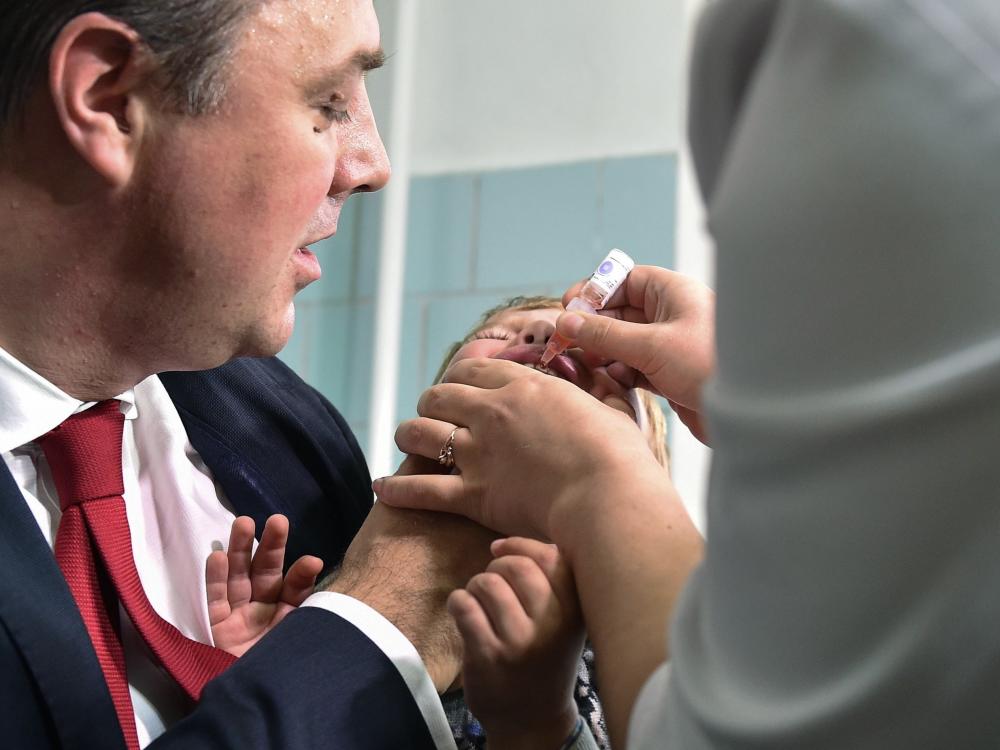This week, the World Health Organization is sending a blunt message to Ukraine: declare a state of emergency.
The reason: two children in Southwestern Ukraine were diagnosed with polio in September.
Even two cases of polio is a concern, especially since these are the first cases of the virus in Europe in five years.
But why is it cause for a state of emergency? That’s what we asked the World Health Organization and other experts. What we found out is that the re-emergence of polio could actually have a silver lining when it comes to childhood health issues in Ukraine.
How did polio re-appear?
The oral polio vaccine, used in Ukraine, contains a weakened live virus that can be shed in stool. Usually, that’s not a problem. In fact, it can be a force for good. The weakened virus can confer immunity on someone who’s not been vaccinated. But in rare cases, the weakened virus can mutate, grow stronger and infect the unvaccinated. And in Ukraine, there are many children who are vulnerable. On average, the vaccination rate for infectious diseases in that country is around 50 percent.
Why so low?
There’s a lot of distrust of vaccines. In 2008, a teenager who’d recently received the measles and rubella vaccines died of sepsis. The World Health Organization and UNICEF both reported that the boy’s death was unrelated to the vaccine, but worry persists about all vaccinations. In addition, parents in the Ukraine are ill-informed about the risks of polio. A 2014 UNICEF/WHO survey found that only 18 percent of Ukrainian mothers think polio is a dangerous disease and only 27 percent know that it can cause paralysis.
Even the medical profession is leery of vaccines. If a child in Ukraine dies within 30 days of receiving a vaccine, the vaccine is listed as a cause of death until the investigation is completed. During that time the licenses of health professionals who administered the vaccine are suspended and the professional could even be jailed, says Dorit Nitzan, head of the WHO office in Ukraine.
But the most critical point is that there’s an inadequate supply of vaccines for polio (and other infectious diseases). According to Clio Van Cauter, a spokesperson for the Global Alliance Vaccine Initiative, Ukraine buys vaccines for regular immunization programs through local networks, resulting in high costs — and vaccine shortages. “If the country used more internationally acceptable procurement methods (like UNICEF), the national budget should be enough to cover the cost of the vaccines,” Van Cauter wrote in an e-mail.
How did the government react to the two cases in September?
The Ukrainian government launched a polio vaccine campaign in October. The goal was to vaccinated 90 percent of children five and under for the first phase and Canada is financing this campaign and the oral polio doses are being brought in by UNICEF. This government campaign is getting support and assistance from the partners of the Global Polio Eradication Initiative which includes WHO, UNICEF, The U.S. Centers for Disease Control, the Gates Foundation and Rotary International.
How’s the campaign doing?
The target for the first phase was to vaccinate 90 percent of children five and under. In addition, unvaccinated children ten and under are being targeted. In all cases, three doses of the oral vaccine are needed. WHO says that reports of the polio cases were a key factor in getting parents on board. But by early November, only around 60 percent of the five-and-under children had been vaccinated. So that’s why WHO called for a health emergency.
What would happen if the government agrees and declares an emergency.
The declaration would mobilize other government divisions to support the vaccination campaign, says Oliver Rosenbauer, a spokesman for WHO’s polio eradication program. So the information ministry could produce public service announcements about the campaign, and the transportation ministry could carry vaccines throughout the country.
Could there be a silver lining to this crisis?
Public health officials hope that the polio vaccine drive could create a better supply-and-distribution system for all vaccines as well as greater public awareness of the importance of vaccines. UNICEF, for example, has included messaging about the need for other vaccines in materials it created for the polio campaign.
“This is being seen as an opportunity to reinvigorate the immunization system in the country,” says Rosenbauer. “The polio outbreak has put the spotlight on the dangers of vaccine coverage gaps.”
How critical is the need to reinvigorate other vaccine programs in Ukraine?
UNICEF estimates show that rates of measles vaccination fell from 70 to 80 percent in 2008 to about 50 percent in 2012 and the number of measles cases rose from about 40 in 2010 to a whopping 13,000 in 2012.
9(MDA3MTA1NDEyMDEyOTkyNTU3NzQ2ZGYwZg004))
